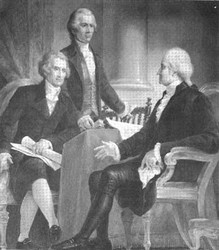Alexander Hamilton And Thomas Jefferson
|
| updated |
Copy Link Code
|
 Thomas Jefferson vs Alexander Hamilton, one of the chief rivalries at the center of American politics through the first two decades, split the nation by ideology and purpose. Hamilton, a staunch Federalist, and Jefferson with his agrarian democracy, could not agree on much in regards to the structure and role of government. During the first term of the Washington administration, Thomas Jefferson and Alexander Hamilton were both serving on the Cabinet as the Treasurer and Secretary of State respectively. Their constant disagreements over fiscal policy, such as Hamilton's proposal for a central bank, led to Jefferson's resignation from the administration. President Washington would hold a grudge against Thomas Jefferson for the rest of his life after the latter formed an anti-administration party with James Madison. The factionalism caused by the Alexander Hamilton vs Thomas Jefferson rivalry would eventually lead to the formation of the country's first political parties. Hamilton's Federalists held the early advantage over Jefferson's Republicans, later known as the Democratic-Republicans.
Thomas Jefferson vs Alexander Hamilton, one of the chief rivalries at the center of American politics through the first two decades, split the nation by ideology and purpose. Hamilton, a staunch Federalist, and Jefferson with his agrarian democracy, could not agree on much in regards to the structure and role of government. During the first term of the Washington administration, Thomas Jefferson and Alexander Hamilton were both serving on the Cabinet as the Treasurer and Secretary of State respectively. Their constant disagreements over fiscal policy, such as Hamilton's proposal for a central bank, led to Jefferson's resignation from the administration. President Washington would hold a grudge against Thomas Jefferson for the rest of his life after the latter formed an anti-administration party with James Madison. The factionalism caused by the Alexander Hamilton vs Thomas Jefferson rivalry would eventually lead to the formation of the country's first political parties. Hamilton's Federalists held the early advantage over Jefferson's Republicans, later known as the Democratic-Republicans.
With an electoral loss to his old friend and Federalist candidate, John Adams, contemporary laws made Jefferson the Vice President. His leadership of a very vocal opposition did not cease, however, despite threats posed by the Quasi-War of 1796 and subsequent reactionary policies enacted by the Federalists including the Alien & Sedition Acts. In the election of 1800, which Jefferson considered a peaceful revolution, the Democratic-Republican coalition of Thomas Jefferson and Aaron Burr received the majority of votes over Adams' bid for re-election but the two running mates had split the vote evenly in the electoral college, sending the decision to Congress. It was there that Alexander Hamilton, leader of the influential High Federalist faction, became kingmaker.
The Alexander Hamilton vs Thomas Jefferson chart got its biggest point on the positive side with this decision. In a choice between Jefferson and Burr, Hamilton actually preferred the former as more principled and less of a threat to the institutions built by previous administrations of Federalists. The hatred between Hamilton and Burr was stronger than the rivalry of Alexander Hamilton and Thomas Jefferson; indeed, the two would partake in a duel near the end of Jefferson's first term in which Burr mortally wounded Hamilton. Although Burr would never face charges for murder, Jefferson dropped him from the ticket in his bid for re-election, ending Burr's political career. In the Alexander Hamilton biography, we find that it was his undermining of Burr's bid for the Governorship of New York that led to their fateful challenge. During his second term, President Jefferson was able to weaken or dismantle many of the departments and functions of the federal government that Federalists had created, including the central bank originally founded by Alexander Hamilton. In his efforts to return the nation to principles originally evoked in the Articles of Confederation, Jefferson gave birth to a form of democracy that would take his name. Based on an ideal of agrarian communities and a voting populace of white property-owners, Jeffersonian democracy is still upheld by opponents of large, centralized government.
